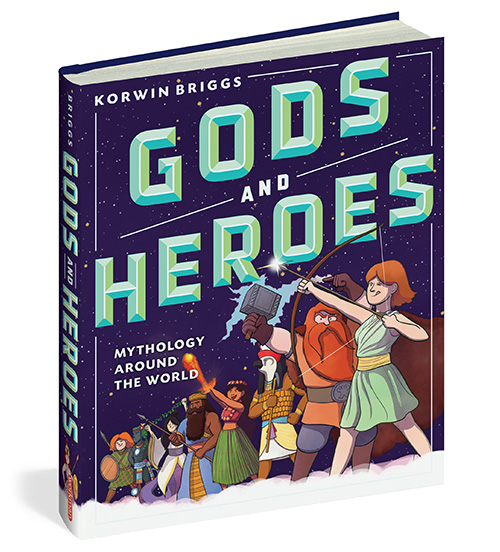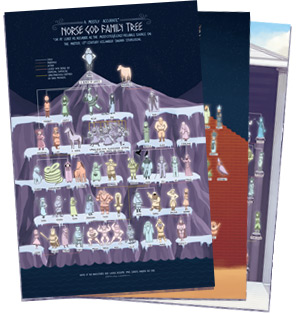Mummy Brown and Other Historical Colors
Update: I made a poster version! It has several new colors.
First, a note: I considered actually buying, using, and scanning all of these colors, but I didn’t because a good chunk of them are expensive, toxic, and/or no longer exist. What you’re seeing is a digital approximation of paint-blobs-on-paper.
Second, another note: I got a C- in chemistry, and that was only because the teacher was really, really nice. I’ll do my best to faithfully repeat what I’ve read here, but you could replace all instances of “chemistry” with “magic” and I’d hardly know the difference.
Third, colors (in order of appearance):
Umber (Prehistory)
A lot of the earliest pigments had iron in them. Iron oxide, actually, which looks rusty because it is literally rust. Umber is the darker brown you see in a lot of cave paintings.
Red Ochre (Prehistory)
Even more rusty, because it’s got even more rust. Technically it’s mostly hematite. Red ochre is the reddish bit you see in a lot of cave paintings. It also makes for some totally ridiculous looking reddy-purple soil in some areas.
Yellow Ochre (Prehistory)
As above, but this time it’s mostly limonite. I gather that these are types of ironic ore. Is it ironic or irony or iron ore? I wish for the first but I’m sure it’s the last. So much pun potential, ruined. It’s the yellowy parts of a lot of cave paintings.
Sidenote: There are also purple and brown ochres, but they’re also iron-based and you don’t see them nearly as often in art supply stores so I didn’t bother putting them here.
Other Sidenote: While I was researching pigments, I found out that cavemen would use sticks, feathers, hairy proto-brushes, blow-guns, fingers, hands, and their mouths to paint. How cool is that? It’s like if Rafiki was an abstract expressionist. Which, now that I think about it, is almost true. He could make a lot of money if he’d only wear a beret.
Chalk White (Prehistory)
People have been using chalk for a very, very long time. Once a teacher threw an eraser at me and it left a mark on my jacket for a week. If only I’d known we were part of a tradition going back to the earliest humans and their earliest cave walls.
Malachite (Ancient Egypt)
You know how copper rusts green? Like, the Statue of Liberty is made of copper. Malachite is sort of like the Ochres, except instead of an oxidized iron ore, it’s an oxidized copper ore.
Azurite (Ancient Egypt)
And azurite is made from a different oxidized copper ore.
Orpiment (Ancient Egypt)
This was one of the brightest yellows in the ancient world, but contained arsenic, which is very very toxic.
Realger (Ancient Egypt)
And so did this, except slightly different composition which made it red instead of yellow.
Egyptian Blue (Ancient Egypt)
Now this one’s interesting. It was the first artificial pigment, invented more than 4000 years ago, and saw wide use in the ancient Mediterranean world. But after the fall of Rome, people sort of forgot how to make it, and then mostly forgot it existed. In the early 19th century, some archeologists found a pot of “pale blue color” in the ruins of Pompeii, but they didn’t know what it was either, so it sort of sat in storage for fifty years before someone realized what it was. Now we’ve figured out how it’s made again, so you can go buy a tube of Ancient Egyptian secrets for like $20.
Another weird factoid: in addition to the blue we see, Egyptian Blue gives off infrared light, which is cool because it means we can use infrared scanners to figure out where it was painted on things long after the paint’s faded/decayed/fallen off. That’s how scientists discovered it in some renaissance paintings, but I can’t find any source explaining how it got there.
Sidenote: Apparently Egyptians used a really limited palette, made mostly of bright colors, and had a very, very limited range of legally acceptable ways to use them. See, for Egyptian painters, color wasn’t a thing to be smeared around willy-nilly-like. Each hue had serious symbolic meaning, and each painting was done for a specific purpose, often religious/spiritual. Not that I know anything about the rules themselves, but still. Interesting.
Lead White (Ancient Greece)
It’s increasingly hard to find this in stores because it’s, you know, toxic. For a while it was also used in cosmetics, which didn’t go so well.
Sepia (Ancient Greece)
Sepia ink was used a lot in Greece and Rome. They’d squeeze it out of cuttlefish. You know those famous pictures of tanks and helicopters and stuff in Leonardo da Vinci’s notebooks? Cuttlefish inksquirts.
Verdigris (Ancient Greece)
The name literally means Greek Green. It’s a very particular kind of rust that forms on copper plates when they’re exposed to wine. People would pile plates on top of one another and cover them in wine and then leave them for days to make the pigment. I read that it has something to do with the acidity of the wine, but don’t quote me on that.
Vermillion (Ancient Rome)
Made of powdered cinnabar, which is full of mercury. I’ve read that it was used sporadically for thousands of years, but the Romans used it way more so I’m sticking it here in the list. Apparently it was so rare and valuable that the Romans had to make laws controlling its price or no one could ever afford it. It was occasionally used in cosmetics, which went about as well as you’d expect. The Chinese also used it, and a couple hundred years after Rome fell they worked out how to synthesize it from mercury and sulfur. Bright red antique Chinese vases? Vermillion.
Madder (Ancient Rome)
This was also definitely used before Rome. I honestly can’t remember why I listed it under Rome, but I did. What did I write in my notes? Are these even letters? Come on, Korwin, keep it together.
Anyway. Madder is made from the roots of the madder plant. It was a cheap, nontoxic, not-quite-as-bright-but-still-passable alternative to things like realgar and vermillion, so it saw a lot of use. I read somewhere that it was the main dye in the British Redcoats’ red coats, as well as the French Redpants’ red pants. I know no one calls French soldiers Redpants but seriously, look at them. (LINK)
Tyrian Purple (Ancient Rome)
Made of snail shells. There were laws in Rome that said if you wore purple and you weren’t the emperor you were in big trouble.
Ultramarine (Middle Ages)
Ultramarine was made of crushed Lapis Lazuli, a valuable gemstone that was extremely rare outside of some big mines in Afghanistan. Fun fact: you can sometimes tell how rich a patron was by how much blue was in the paintings they commissioned. Lots of ultramarine? You know that was expensive.
Naples Yellow (Renaissance)
Here’s another lead-based pigment. Or it was. If you buy a tube of paint labelled “Naples Yellow” today you’re probably getting a less toxic substitute. Naples Yellow was used by a lot of the old masters starting in the 1600’s. I also found some things saying it was used in ancient history too, but not enough that I felt confident sticking it there.
Smalt (Renaissance)
A different, still-expensive-but-not-literally-made-of-gems blue. Also the main blue used in that blue and white Chinese-style porcelain that somehow ends up in every grandmother’s kitchen.
Carmine (Renaissance, I think)
Literally boiled beetles. There are a few kinds of bugs that make the pigment in their shells, and they like to hang out on trees, so folks would go out into the woods with a bucket, load it up with beetles, and then boil ‘em up and sell the dye. Wikipedia claims that it’s added to ruby-red grapefruit juice to make it redder. I wonder if we still get it from beetles?
Van Dyke Brown (Renaissance)
Sometimes also called Cassel Earth. It’s made from peat, which is another word for sopping wet semi-solid chunks of long-decayed plant matter.
Indian Yellow (Early Modern)
Here’s an interesting one. The story goes that it was made in some obscure Indian village where they fed cows nothing but mango leaves, which left them malnourished but made their pee bright shining yellow. People would collect the pee, dry it, press it into cakes, and eventually some of it would arrive in Europe. That’s the story, anyway. As far as I can tell, no one actually knows for sure how it was made, nor have they really tried. If you buy “Indian Yellow” today, you’re getting an artificial mixture of things that aren’t mango-cow-urine. What a rip off.
Indigo (Early Modern)
I’ve listed this as early modern because that’s when Europeans started using it in serious quantities, but indigo (made from the indigo plant) was available long before that in the warmer, wetter parts of Asia. Indigo dye was a big business for the British East India company in the same way that telephones were a big business for the Bell Telephone Company and the red spaces were big business for a friend of mine the last time we played Monopoly. I don’t like Monopoly.
Gamboge (Early Modern)
Made from east Asian tree gum, which I think is just a word for thick tree sap. Rubbery tree sap, maybe? Either way, this was an odd one in that it wasn’t a powder that you’d mix with water or oil or whatever, like all the others on this list, but was a gummy substance on its own.
Blue Verditer (Early Modern)
Blue Verditer is basically just a better version of Azurite, with finer particles. I have no idea how it was made but I gather it involved some chemical know-how that wasn’t know-howed until the 1700’s
Azure (Early Modern)
Like Blue Verditer in terms of being an old color made better through advancements in chemistry.
Mummy Brown (Early Modern)
Ground up Egyptian mummies (mixed with a couple other ingredients). I’d make a joke about flesh-tones, but I already did that in the comic itself, so instead I’ll just tell more non-jokes: it was pretty popular, it tended to crack with age, and people stopped making it partly because manufacturers started running out of mummies and partly because artists realized their paint was people.
Prussian Blue (Early Modern)
A wholly artificial pigment first synthesized in Berlin in 1706, but only available to artists a couple decades later. Remember how ultramarine was just crazy expensive? Prussian blue isn’t. There’s a reason paintings start looking a lot bluer in the 1700’s, and that reason is Prussian blue.
Cobalt Green (Early Modern)
Invented in Sweden around 1780, using cutting-edge technology. It involves cobalt and zinc.
Chrome Yellow (Industrial Revolution)
First discovered in the late 1700’s in Siberia, chromium turned out to be really really great for making bright colors. Chrome Yellow was inexpensive but unfortunately tended to darken over time, so these days it’s been mostly replaced with cadmium yellow. Chromium also makes for really, really shiny alloys, like the bumpers on every car in the 50’s.
Viridian (Industrial Revolution)
Invented in 1859 in Paris. Also chromium-based, and you can still buy it today. I found a cool story about how a Van Gogh painting was proven fake because it used modern viridian paint, and we’re so good at manufacturing that nowadays that you can date paintings by the impurities that older tubes used to have in them. I don’t know if it’s true, but I hope it is.
French Ultramarine (Industrial Revolution)
Here’s the holy grail of color chemistry – a version of ultramarine that’s NOT made of crushed gems from Afghanistan. I found no mention of Afghanistan’s reaction to what I assume was a sudden, precipitous drop in the price of lapis lazuli, but I’m sure it was fine. Probably.
Scheele’s Green (Industrial Revolution)
So one thing that’s come up a few times in these comics is the relatively lax (read: nonexistent) safety standards of 19th century America. So it was with Scheele’s green. People loved Scheele’s green. They used it in wallpaper and clothing and newspapers and toys and candles and loads of things. Problem was it was full of arsenic, and had a habit of releasing toxic particles and/or gasses and/or vapors into the air around it. So we have stories of kids dying from green candles, women getting ill in green dresses, and one maybe-plausible-but-unproven theory that Napoleon Bonaparte might have died of arsenic poisoning from years spent near green wallpaper (but then I read somewhere else that the amount of arsenic in his body, while high, wasn’t abnormal for a 19th century dude because, again, safety standards).
Emerald Green (Industrial Revolution)
It didn’t take long before people started trying to improve on Scheele’s green. Not because it was poisonous, but because it would fade over time. In this, emerald green was marginally better. Still killed people though, so eventually they retired the paint and used it as rat poison.
Mauveine (Industrial Revolution)
The first synthetic organic chemical dye, invented by accident in 1856. It’s sometimes been sold under the name Tyrian purple, but don’t let those marketers fool you: there are no snail remains here. I read that it was wildly popular for a while there, because Victorians loved Chinese stuff, and they thought purple looked Chinese. It’s still popular because, you know, purple.
Zinc White (Industrial Revolution)
Finally, a white that doesn’t kill you! It’s literally just zinc oxide. It was also sold under the name Chinese White, because again, Victorians loved Chinese stuff. Kind of a bummer that didn’t translate into more love for Chinese autonomy, or Chinese lives, or Chinese not-being-sold-smuggled-drugs-for-decades, but I guess you can’t win ‘em all.
Sidenote: I might have mentioned it in a previous comic, but I think a lot of 18th and 19th century European fashion and design is really cool for its non-European influences. Usually this means places they threatened, killed, conquered, or colonized – Egypt, the Middle East, India, China, Japan, etc. But it leads to such cool looking stuff – Napoleonic mashups of military-looking and Egyptian-looking stuff, giant exhibitions, and don’t even get me started on Japanese-inspired prints. I’m not saying colonialism was good, but it sure did look cool.
Sidenote: I totally forgot to include Titanium white on this chart. It’s a very cool white. By which I mean it makes things more bluey – add it to red and you’ll get a pale purply pink. Does that make sense? If you painted the same scene twice, one mixing all your light colors using zinc white and one using titanium white, the first would look more like incandescent lighting and the second more like fluorescent. I love that titanium’s nontoxic, and I totally get that it has a role, but given a choice I’ll almost always prefer zinc or lead white. And that’s all I have to say about white.
Magenta (Industrial Revolution)
Originally called Fuschine, but later renamed in honor of the battle between the France, Austria, and Sardinia (one of the smaller kingdoms that later united to become Italy). The magenta that we use today in CMYK printing is slightly different and was invented later, but unless you see both at once it’s hard to tell the difference.
Anise Blue (Industrial Revolution)
One day some workers messed up making magenta pigment and it turned blue. They called it Anise Blue, after a flower that is sometimes blue.
Alizarin (Industrial Revolution)
You remember madder? French-Redpants Madder? Alizarin is the chemical that makes it red. In 1868 some chemists managed to create the same chemical from scratch in a lab, and the rest is history.
Synthetic Indigo (Industrial Revolution)
You remember indigo? Exclusive-Product-of-the-East-India-Company Indigo? In 1882, a German chemist named Adolf Von Baeyer managed to synthesize it in his lab. In 1905 he won a Nobel prize “in recognition of his services in the advancement of organic chemistry and the chemical industry, through his work on organic dyes and hydroaromatic compounds.” I’m sure the Nobel prize wasn’t for ruining the East India Company’s monopoly on indigo dye.
And that’s that. Maybe I’ll make this into a poster at some point and add some of the colors I missed (UPDATE: I did!). I wish I’d put some more non-western pigments in there. I even found a couple distinctly non-western ones, like Han Purple, Maya Blue, and “Dragon’s Blood,” but by time I read about them I’d already finished the comic and honestly, it’s been too long already. So next time. Next time. Speaking of which, next time maybe I’ll try to find something African? I just got a cool book on world history, and world history includes African history, so maybe I’ll find something funny and/or interesting to draw.
~Korwin



